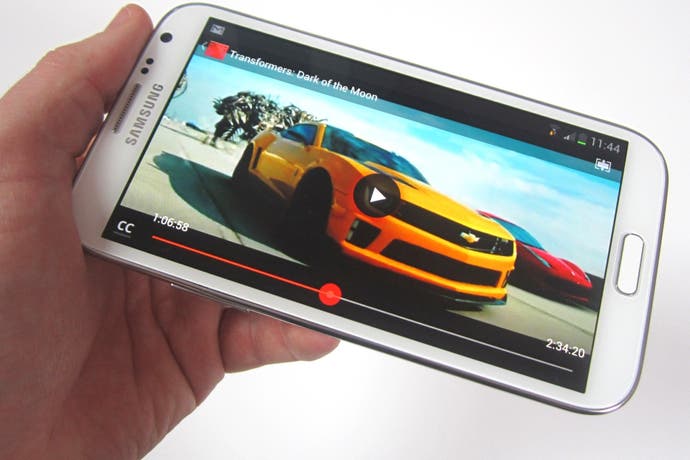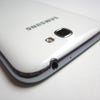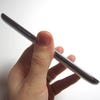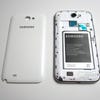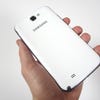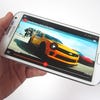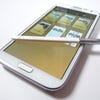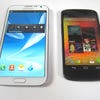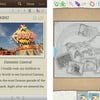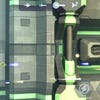Samsung Galaxy Note 2 review
Everyone's favourite phone/tablet hybrid gets a makeover. Digital Foundry tackles the biggest Android phone yet.
The original Samsung Galaxy Note was a concept that really shouldn't have succeeded; a phone with a finger-stretching 5.3-inch screen by rights should be a laughable spectacle, yet it found a receptive audience and at the time of writing has sold five million units worldwide. Such was its popularity that Samsung has released a successor in double-quick time and true to form has equipped it with an even larger display. We can hear trouser pockets all over the globe groaning with discomfort already.
However, increased screen size isn't the only thing the Galaxy Note 2 brings to the table. It's packing a Exynos 4412 chipset which contains a quad-core 1.6 GHz Cortex-A9 CPU, aided by a roomy 2GB of RAM. There's some fearsome power contained within the imposing frame of this massive mobile, as well as Android 4.1 (also known as Jelly Bean) and a smattering of exclusive Samsung applications which take advantage of the phone's signature S Pen stylus.
There's no escaping it - the Galaxy Note 2, like its forerunner, is gigantic. It straddles the divide between mobile phone and tablet quite awkwardly, never really feeling like it can be classified as either device. The Note 2's immense proportions also make it difficult to cram into all but the most accommodating pockets, and it's more comfortable when riding inside a satchel or handbag. For those who like to travel light, this is likely to present quite an issue.
Samsung's love of glossy plastic remains unchecked and the Galaxy Note 2 is notable for the complete absence of metal surfaces. The shiny trim which runs around the edge of the phone is simply plastic with a faux-metal coating, and the battery cover is a wall of fingerprint-attracting material. Even so, the handset never feels cheap and nasty; it's got a reassuring heft to it, and when the rear cover is snapped into place the device is solid and robust.
Like its predecessor, a fair degree of the Galaxy Note 2's unique functionality revolves around that unique S Pen stylus. It docks in the bottom-right corner of the handset and is utilised in a wide variety of ways - some of which we'll come to later. The new-look S Pen has a flat edge which makes it easier to grip, and a button which allows you to change how the capacitive screen reacts to its touch.
Utilising Electro-Magnetic Resonance (EMR) technology, the stylus is incredibly accurate, even more so than the traditional pressure-based pen you'd encounter on a device like the Nintendo 3DS or the Wii U GamePad. Its most impressive party trick is the fact that it works even when the tip isn't touching the screen - this "floating" state (dubbed "Air View" by Samsung) is used to show additional information about menu selections, similar to rolling your mouse pointer over an image on your PC monitor.
"The stylus is incredibly accurate, even more so than the pressure-based pens used on the Nintendo 3DS and Wii U."
Naturally, whenever you have something which detaches from your handset there's the ever-present danger that you could lose or misplace it - especially when you're on a crowded bus or in a packed bar. Thankfully you can enable a feature which makes the phone emit an audible warning when you walk away without the S Pen docked - whether or not you'll be able to hear this over the din is another matter entirely.
The screen's the star
The 5.5-inch Super AMOLED Plus screen is larger than the one seen on the previous model, but the overall resolution takes a slight tumble from 800x1280 pixels to 720x1280 pixels. The reason for this resolution reduction - which also brings the pixel density down from 285 to 267 ppi - is that the Galaxy Note 2 boasts a 16:9 aspect ratio screen, making it better suited for watching movies.
One of the most obvious benefits of that powerful quad-core hardware is performance. Lag and jerkiness have accompanied Android almost from day one, and it's only now that these unfortunate issues are being put to bed. The Galaxy Note 2 is responsive and smooth, challenging the Nexus 4 for sheer user satisfaction. Application loading is lightning fast, the camera boots up in double-quick time and navigating the web is a real joy - something which is accentuated by that large screen, giving an almost tablet-like experience for web addicts.
| Galaxy Nexus (Android 4.1) | HTC One X | Nexus 4 | Galaxy Note 2 | |
|---|---|---|---|---|
| Quadrant Standard | 2078 | 4870 | 4906 | 5765 |
| AnTuTu Benchmark | 4724 | 11065 | 10580 | 13305 |
| Vellamo | 1199 | 1661 | 1314 | 2421 |
| GLBenchmark 2.5.1 Egypt HD On-Screen/Device Native Res | 8.3FPS | 21.7FPS | 39FPS | 18FPS |
| GLBenchmark 2.5.1 Egypt HD Off-Screen/1080p | 5.4FPS | 14FPS | 31FPS | 17FPS |
Most Android devotees will tell you that manufacturer-created skins - which sit atop the core Android operating system and are generally responsible for the fragmented nature of the marketplace - are a thoroughly bad idea, but when they're done well they can make the device in question feel entirely different from its competitors.
That's most certainly the case with the Galaxy Note 2; its custom TouchWiz UI is bursting with unique features and ideas. Some we've already seen on the Galaxy S3, but there are others which tie in directly with the aforementioned S Pen.
"OEM skins are usually frowned upon by Android enthusiasts, but Samsung's TouchWiz UI is bursting with unique features and ideas."
The moment you remove the S Pen from its dock, the phone offers up relevant shortcuts that make use of the stylus, allowing you to swiftly jot down a note without having to trawl through your phone's application drawer to find the relevant program.
Another neat use for the stylus is "cutting" out sections of the screen to send to friends via Bluetooth or email - while this might seem a bit unnecessary when Android has screen capture baked-into the OS, it allows you to embrace your artistic side and create scrapbook-style collages.
Another revelation is the ability to run two applications on the same screen. Pressing the holding the back button opens up a slide-in menu on the left-hand side of the screen; by dragging and dropping the application icons stowed away in this menu you can load up two of your most-used apps and run them in tandem. This only works with certain programs at present, but they cover all the important bases: email, gallery, Twitter and web browsing, to give just a few examples. Another cool feature is the pop-out video player, which allows you to watch a movie in a floating window while performing other tasks.
"The massive 5.5-inch Super AMOLED Plus screen with its 720p resolution is a boon for mobile gaming."
The Galaxy Note 2's massive screen is matched by an equally formidable 3100 mAh battery. Some of that additional stamina is naturally required to satisfy the demands of the 5.5-inch display, but even so, the power cell has impressive staying power.
As is usually the case when reviewing a handset, we indulged in some pretty heavy use on the first day of the test - surfing the web, playing games, watching HD videos, that kind of thing - yet the Galaxy Note 2's battery was still goading us for more punishment as the day came to a close. With a more moderate usage pattern you can easily get two days or more out of a single charge - something that, in our personal experience at least, has never been possible for Android power users. Even better, the battery is replaceable, so you can always carry a spare for those long trips.
The original Galaxy Note was a mobile gamer's dream - the massive screen provided the perfect platform for portable entertainment. Given its enhanced specifications, it should come as no shock to discover that the same is true of the Galaxy Note 2; games such as NOVA 3 and Jetpack Joyride look beautiful on the large display and the powerful Exynos 4412 chipset appears well equipped to handle more advanced titles. Performance is impressive overall and the S Pen comes in handy as a surprisingly effective alternative to using your fingers.
"We really enjoyed using this device, and once again it illustrates just how far Samsung has come in the past few years."
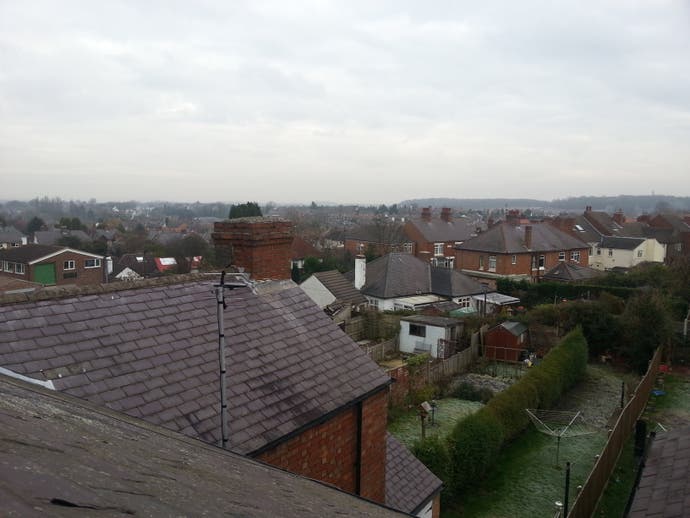

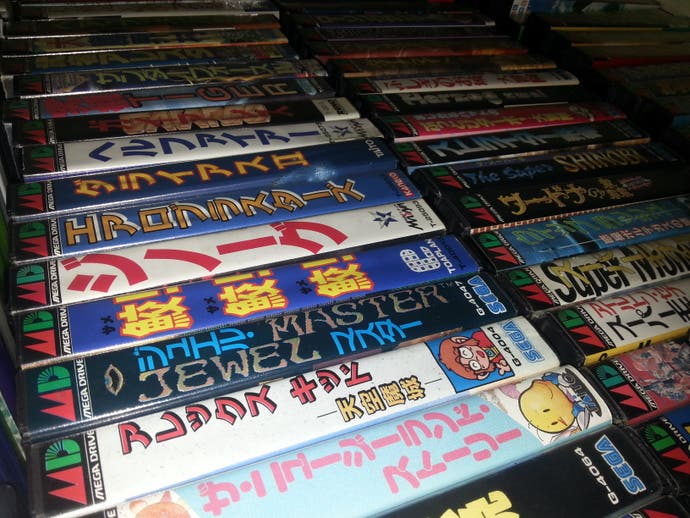
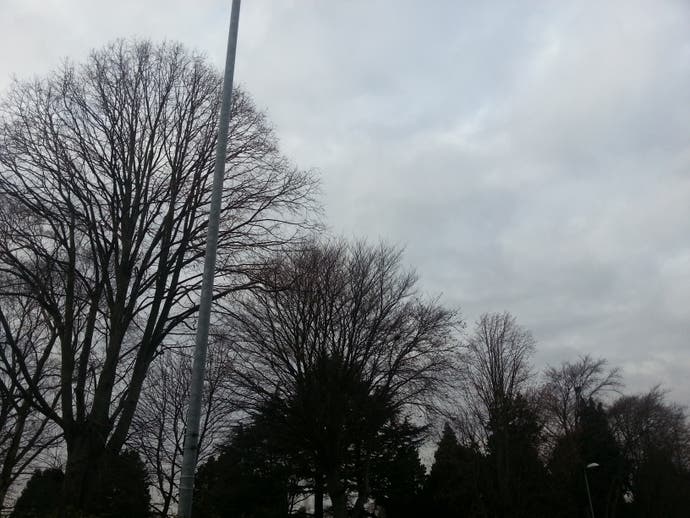
Galaxy Note 2: the Digital Foundry verdict
Samsung has taken a fairly traditional upgrade path with the Galaxy Note 2; it's larger and more powerful than its forerunner, with better software and vastly improved interface. However, none of this matters if you found the original Note to be too gargantuan for your Hobbit-like hands and skinny-jean pockets; the phone's dimensions are unquestionably a bone of contention and push this device off the radar of many consumers.
Despite this barrier to acceptance, the track record of the Note proves that a market exists for large-screen handsets such as this one; you only have to look around you when you're next on the tube or bus to see how popular the product has been with the general public. Whether or not this sequel can emulate the stellar sales of its ancestor remain to be seen but we really enjoyed using this device, and once again it illustrates just how far Samsung has come in the past few years.
Thanks to Vodafone for supplying the phone used in this review.
